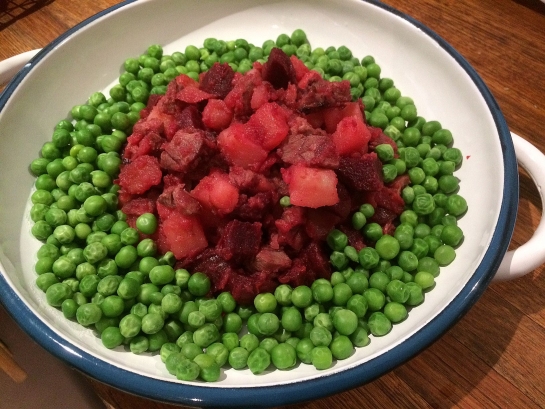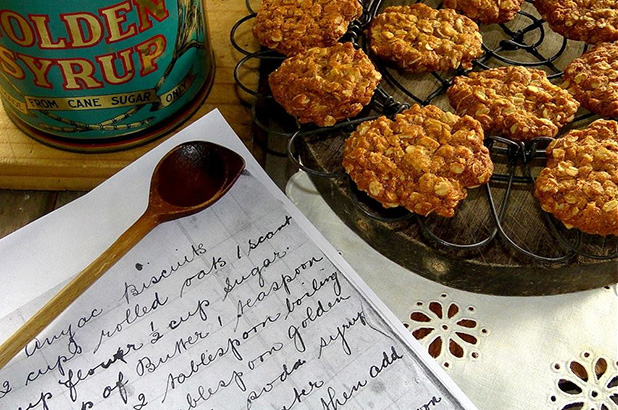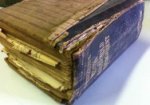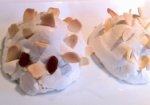While World War II battled on across the globe, Australians at home responded to a call for arms in a more localised sense to do ‘their bit’ for the war effort. People were encouraged to be as self sufficient as possible, by growing their own fruit and vegetables and being prudent with imported products, and locally sourced grain, meat, eggs and dairy products that could be exported or used in other ways to support Britain and her allies.
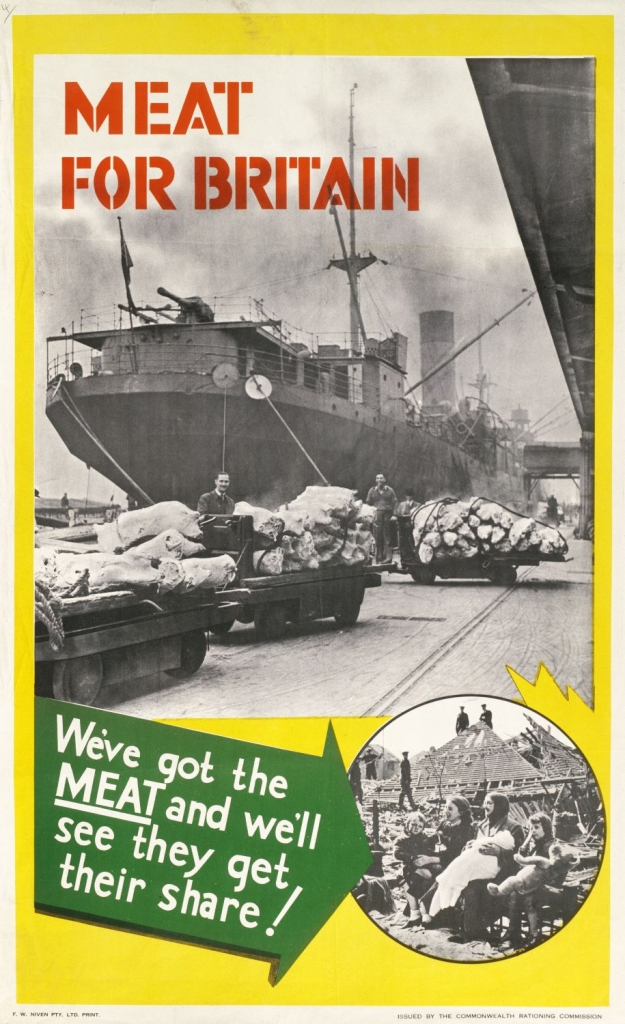
Meat for Britain, Commonweatlh Rationing Commission (Publisher); FW, c 1943 ECL #176
AWM: ARTV00260 © Australian War Memorial, Canberra
Housewives were actively recruited to support the war effort by ‘making do’ at home, maintaining morale and keeping the family in good health, so they too could do their ‘bit’ for the war.
“Without praise or glamour, medal or uniform, she holds the morale and the health of the nation in her hands.
Lacking her cooperation and loyalty no war can be won and no peace can be permanent…” Sarah Dunne, Wartime Cookery p. 1
Responding to this, Wartime Cookery by Sarah Dunne captures the mood of the day from a culinary perspective.
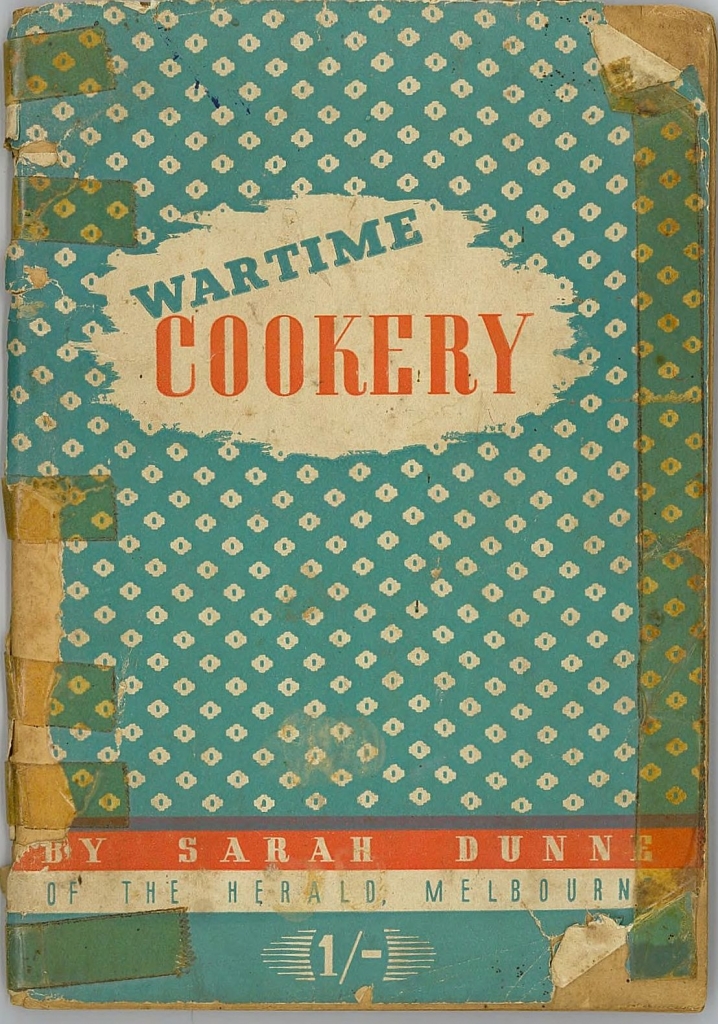
Front cover of ‘Wartime cookery’ by Sarah Dunne. Published by The Herald Melbourne, 1945 © Sydney Living Museums. More substantial than a leaflet at 98 pages it is suitably diminutive given the austerity measures being encouraged at the time.
An armoury of expressions
Sarah Dunne was a journalist with the Melbourne Herald and what sets her book apart from others is her particularly ‘beguiling’ writing style. Recruiting motivating words relating to military operations, the author creates the feeling that the kitchen is a lucrative weapon, the domestic cook is engaged in battle and intelligence will inform her actions and decisions in support of the war effort. Alert to taking strategic advantage over bleak circumstances sections are titled ‘Deceiving the vegetables’ and ‘Cunning Tricks’. Her readers are reminded that ‘cooking should not be stereotyped, unimaginative, dull’ and encouraged to ‘use your wits’ and be a ‘wily cook’ while she compels you to read on by saying ‘let me tell you a secret’
If you are a wily housewife…
It is exciting to plan and save, to invent and camouflage…
See how we can coax [meat] into doing double duty…
Six cunning devices to beguile you…
Sausages camouflaged in golden crumbs or potato…
It is a wise plan…
Now for the secret…
There’s no need to trespass on the butter ration…
A cook has no more potent ally than an attractive pudding…
Overcooking makes the vitamins flee…
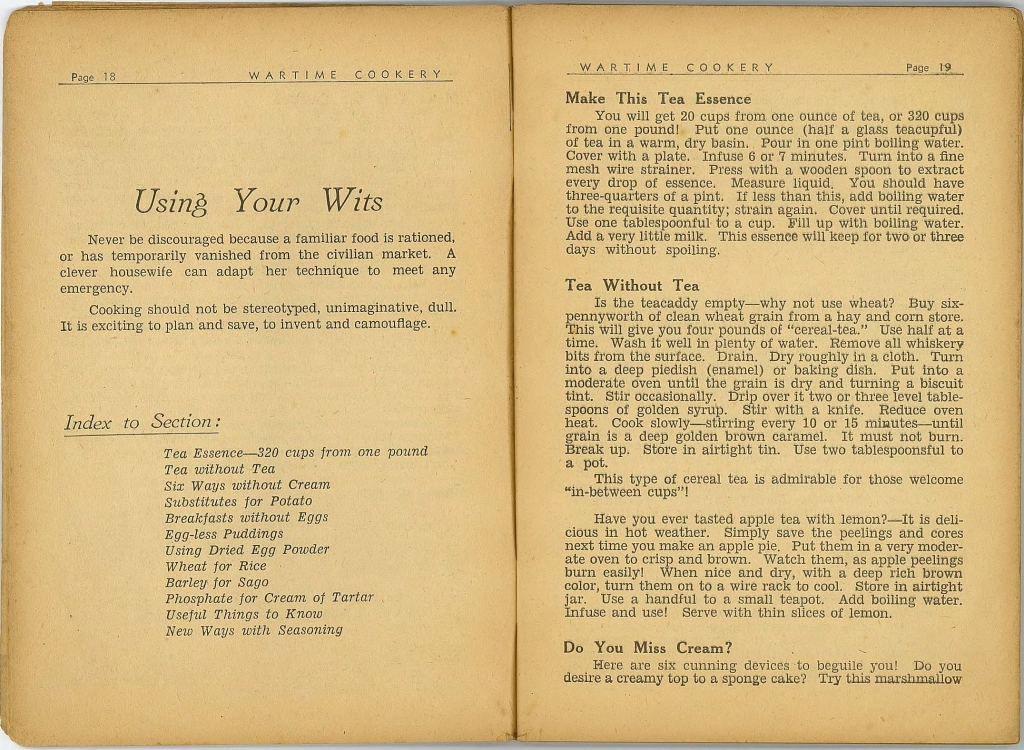
‘Wartime cookery’ pages 18-19. Sarah Dunne, The Melbourne Herald, 1945 © Sydney Living Museums
“Do you miss cream?
While rationing was not as severe as it was in the UK and other parts of Europe, many foods, such as tea, eggs, butter and meat were rationed during WWII in Australia and Wartime Cookery was once of many books and pamphlets that were in circulation to help people manage with limited resources.
Tips, suggestions and recipes abound for eking out precious ingredients or substituting them altogether, such as ‘Cream without Cream’ (whip “cornina” cornflour into milk, butter & sugar), ‘Tea without Tea’ (substitute with roasted wheat), ‘Tea Essence- 320 cups form one pound’ (a concentrate ensuring no remnant of life from the leaves is wasted), ‘Breakfast without Eggs’, ‘Wheat for Rice’, ‘Barley for Sago’. Rabbit was called upon to replace chicken, and baked mashed or grated potato for pastry and brains were suggested in place of oysters, crumbed and fried in dripping.
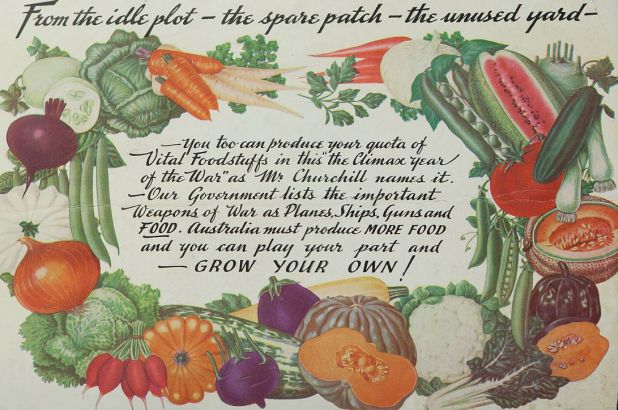
‘The home vegetable plot’ Yates’ seed book of what & when to sow : a real war job! / Arthur Yates & Co. [trade catalogue]. Caroline Simpson Library and Research collection. stack TC 635 YAT/35. Photo © Jamie North for Sydney Living Museums
Red flannel hash
Modern readers may rightly feel that the food on offer is rather humble, and dishes such as Glorified steak, Mock Chicken, Pretence Souffle, and Mystery Turnover (could it be Fish?) hardly foster confidence. The need for austerity conjures images of depressing, dreary and unappetising food, however Dunne is unyeildingly enthusiastic and optimistic: ‘never introduce a meat-less dish with an apolgy. It only gives the poor thing an inferiority complex. Bring it in with an air! Call it Dutch or American, Chinese or African – but never breathe the words “meat-substitute”! (p. 63)
She also paid great attention to aesthetics and colour on on the plate, usually by enlisting vegetables – home grown of course!
‘Four people to dinner and only one teacupful of finely chopped cooked meat in the larder! – Make a picturesque “Red Flannel Hash”
Cook enough potato and beetroot to give you tow teacupsful of each when finely chopped. Mix with the meat. Melt two tablespoons of clarified dripping in a frying pan. turn in the vegetables and meat. Stir over heat until it begins to stick to the pan and brown. Add a little boiling water; stir again. Repeat until mixture is soft, thick and very hot. Season with salt and pepper, and a little raw grated onion. give it a final spoonful or two of creamy milk. blend well. Pile in a hot dish. surround with green peas of French beans.
This recipe is a marvellous example of “stretching your ration”!Red flannel hash
Ingredients
- 2 cups cold boiled potatoes, diced into 1 cm cubes
- 2 tablespoons butter or olive oil
- 1 cup cooked whole beetroot, boiled or tinned, diced into 1 cm cubes
- 1 cup cold cooked meat, diced
- 2 cups peas, to serve
- mint sauce, to serve
- milk, optional
Note
This convenient 'leftovers' recipe is from Wartime Cookery by Sarah Dunne (Melbourne, 1945). The beetroot helps 'cammouflage' the fact that the dish contains relatively little meat, but it is surprisingly tasty.
Directions
Heat the butter or oil in a frying pan and once starting to sizzle, add potato pieces. Cook until nicely browned, stirring to prevent sticking. Add beetroot and cold meat, stirring to mix through the potatoes with two tablespoons of water to thicken and help bind the mixture. Cook until heated through, adding a few tablespoons of water as necessary, or for a creamier finish, use milk instead of the extra water.
Meanwhile, boil the peas.
To serve, pile the hash onto the centre of a plate, and surround with peas. Mint sauce or other condiments can be added at the table.
“Is the tea caddy empty?”
Apple Tea with Lemon
Delicious in hot weather. Simply save the peelings and cores next time you make apple pie. Put them in a very moderate oven to crisp and brown. Watch them, as apple peelings burn easily! When nice and dry, with a deep rich brown colour, turn them on to a wire rack to cool. Store in an airtight jar. Use a handful to a small teapot. Add boiling water. Infuse and use! Serve with thin slices of lemon.
Wartime Cookery p. 19
I’ve put this recipe to the test and it makes a surprising pleasant hot drink, and with the addition of a cinnamon quill in the pot, not far removed from Turkish Apple tea. So while traditionalist English breakfast drinkers might be horrified, it makes a nice accompaniment to an Anzac biscuit.
Anzac biscuits. Photo © Nicki Agars, courtesy Allison Reynolds, author, ‘Anzac biscuits, the power and spirit of a national icon.’ Wakefield Press, 2018.
The original Anzac biscuit? circa 1920
Ingredients
- 200g rolled oats
- 125g plain flour
- 100g sugar
- 125g butter
- 2 tablespoons golden syrup
- 1 teaspoon bicarbonate of soda (bi-carb soda)
- 2 tablespoons boiling water
Note
Culinary historian Allison Reynolds is author of 'Anzac Biscuits, the power and spirit of a national icon'. She has kindly shared this recipe which is based on a hand written recipe found in a notebook that belonged to Carolyn Warner in South Australia. Research indicates that it was compiled before 1920, and is one of the earliest recipes to identify the now iconic oat and golden syrup biscuit as an 'Anzac'.
This recipe has less sugar, flour and no desiccated coconut – but double the oats than the more familiar modern-day versions. The original handwritten recipe asks for 1 tablespoon of golden syrup, but experience with this recipe suggests that it was a very generous measure, and works best with 30 mls.
Directions
| Pre-heat oven to 180°C. Put the oats, flour and sugar into a large bowl and mix well. Melt the butter in a large saucepan over medium heat and add the golden syrup (see the Cook’s tip below). Stir till dissolved and just coming to the boil, then remove from the heat (but don’t allow it to cool). Place the boiling water into a small cup, add the bicarbonate of soda and stir until it is dissolved, then add the soda mixture to the saucepan of butter and syrup. Stir until it froths, and immediately add the hot mixture to the dry ingredients and mix all together. | |
| Check mixture is cool enough to handle, then take a flat dessertspoon of the mixture, place it in your hand, and bring together by rolling into a ball. Place 5 cm apart on the baking sheet (they will spread), flattening slightly – use the base of a glass or press down with a fork, dipped in a little flour (this will stop the glass or fork sticking). Put trays in the oven for 15–18 minutes until golden (they will still be soft). Leave the biscuits on the trays for 5 minutes before transferring them to a cooling rack. When the biscuits are cold store them in an airtight tin. | |
| Cook’s tip – when measuring out the golden syrup, dip the tablespoon into hot water so that it slips from the spoon easily, or warm the bottle or tin of syrup by standing in hot water so it isn’t too thick to pour. | |
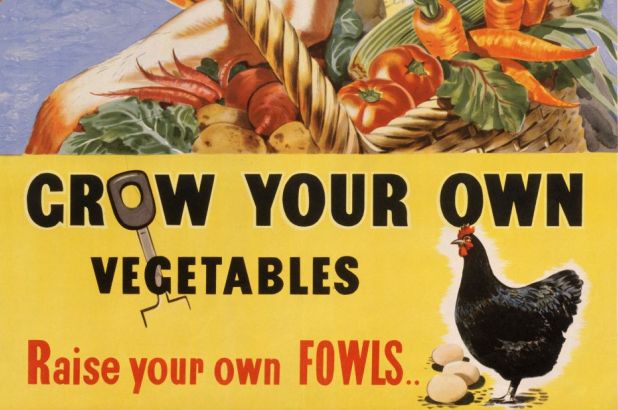
 Print recipe
Print recipe